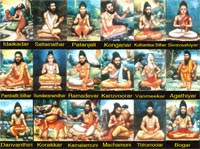State of Godliness is possible to one, who follows the way shown in the Siththar’s poem. Moreover, we cannot see any imaginary information neither praising quotes nor the decorative lines in these poems. There might be possibilities of some exceptions in some poems which belongs to later period.
According to Siththars view, godliness is the well stabled higher state of mankind and that state can be achieved through the regular practice by any person. Many poems can be quoted to prove this statement.
Siththars were highly disappointed with the ignorant fake practice of spirituality on the basis of Godliness state and god. Most of the critics have ignored and rejected these statements and prevented it from reaching the common public. However, some remnants poems are eternal and still present beyond the ages.
In that sense, we will see the following poem of Paambaatti Siththar in this post.
"பூசை செய்தாலே சுத்தபோதம் வருமோ?
poosai seithaalae suththapoatham varumoa?
பூமிவலம் செய்ததனாற் புண்ணியம் உண்டோ?
poomivalam seithathanaar punniyam undoa?
ஆசையற்ற காலத்திலே ஆதி வஸ்துவே
aasaiyatra kaalaththilae aathi vasthuvae
அயைடலாம் என்று துணிந்து ஆடாய் பாம்பே!
ayaidalaam enru thuninthu aadaai paambae!”
Paambaati siththar questioning us regarding the basis of spirituality as, how one can get benefit from the poojas performed on god as daily basis and searching virtue on temple of various places?
One cannot find the state of godliness in form of mankind nor the blessings from certain places. It is eternal thing present everywhere and shapeless structure which can also be felt and seen inside everyone.
One cannot achieve this eternal state by performing pooja neither roaming to find the virtue nor reading the religious books. Paambaatti Siththar says, one can feel and attain this high state by destroying their selfishness and start living with magnanimous thoughts.
Original – www.siththarkal.com
Translated by Lalithambika Rajasekaran









